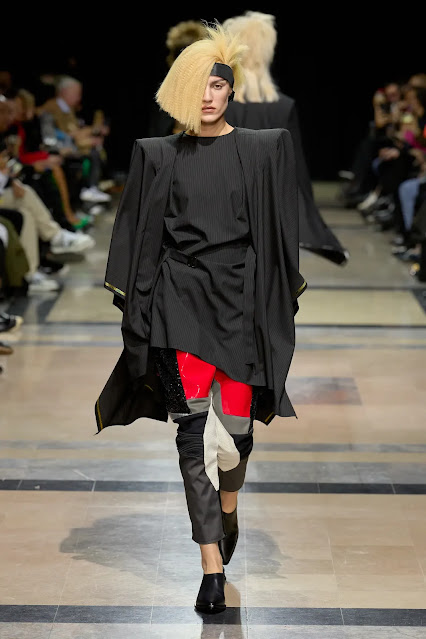Junya Watanabe Spring 2023 - Paris Fashion Week.
There is such an enticing sweet spot for many designers and ones who seek a connection to the past that were the years between 1978 and 1985, as both the 70's and mid 80's gave the possibility of a society still focused on its counter culture at least the liberating aspects of restrained expressions of sexuality. Which unfortunately petered out into the 1990's and vanished only to become a simulacrum of social media feeds of the 21st Century. The creative drive, to which the early 80's offered for designers, at least in fashion, was that inspiration drawn from the punk ethos which developed as a do-it-yourself backlash against conservative styles. That ironically, through a mix and match and stylized messy look, actually was inspired by the modernism looks of the 1950's. Updating the aesthetics into a fusion of recut and oversized blazers, ties and tapered trousers. That in turn, was as a backlash against hippie esque styles that had spilled over into the 70's.
The reserved and enigmatic Japanese fashion designer Junya Watanabe has been a stalwart adherent to the 80's fashion imprint, redefining his study of that era of originality. And it was when he held his debut runway show in 1993 at in Paris, revealing his signature brand for the first time to a European audience. With its deconstructed stylizations, that we got to see how he began, in a respectful manner, in separating himself from his mentor, Rei Kawakubo of Comme des Garçons fame.
After twenty nine years of consistency showing at Paris Fashion Week, Watanabe's fixation of the early 1980's continues to be his everlasting template and his Spring 2023 collection has further instilled Watanabe's devotion of reworking 80's fashion, more so its counter culture looks. The styles presented for his latest collection most definitely are attuned to the Punk look of 40 years ago, with exaggerated shoulder pads of power suit styles with strings of pearls, chains and sheer fishnets looks. Watanabe has also merged the early 1960's modernist prints, seen on smock looking dresses in his fusing timelines of eras gone by.
Yet, the collection holds that irony of antifashion, by refashioning suiting looks that make give it Watanabe's distinctness in his reverence of how significant punk was in its attempt at reshaping fashion. Also noted are Kimono style jackets and blazers, in Watanabe's distinctly Japanese trait in its creative idealism by absorbing Western trends and making them his own.











Comments
Post a Comment